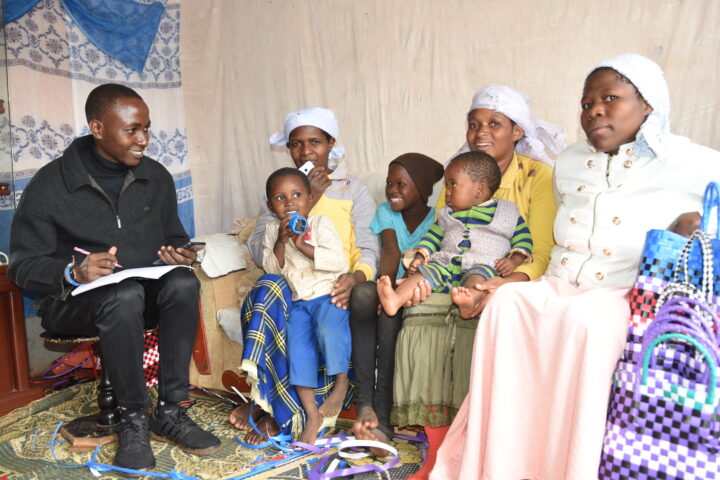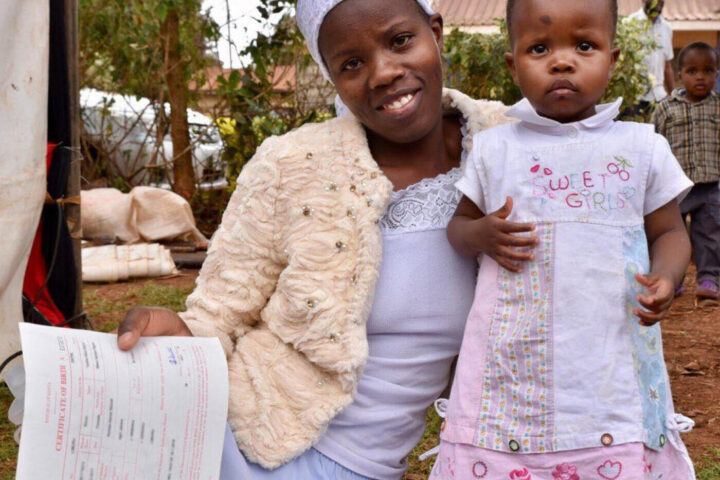Co-authors: Melanie Khanna (UNHCR Chief of the Statelessness Section), Betsy Lippman (UNHCR Senior Advisor for Innovations and Partnerships), Florence Nimoh (UNHCR Associate Economist), and Sebastian Steinmueller (UNHCR Statistics and Data Analysis Officer).
Statelessness, the condition of people who have no citizenship, is a global phenomenon that negatively affects millions of people worldwide. The problem has not gotten the attention it deserves in part because data on statelessness is so weak. Most governments do not collect data on stateless persons, and as a result, there is no reliable global estimate of the number of such persons, although the figure of 10 million is frequently cited.
Moreover, although a number of qualitative studies have documented the many disadvantages faced by stateless people (see for example this report on the impact of childhood statelessness and this report (microdata) on the impact of statelessness on minorities), until now there has been very little quantitative information concerning the socioeconomic impacts of statelessness, including the link between statelessness and poverty.
Results from a new joint UNHCR-World Bank survey provide one of the first data-backed assessments of welfare and poverty associated with the lack of nationality. The study compares the socioeconomic conditions of the stateless Shona community residing in Kenya’s Nairobi and Kiambu counties with those of Kenyan citizens in these counties as well as with the national urban average.

An estimated 18,500 stateless people currently live in Kenya. Most of them are descendants of groups that migrated to Kenya generations ago from countries such as present-day Mozambique, Tanzania, Somalia, Zambia and Zimbabwe. The Government of Kenya, which has been a generous host of displaced populations, has taken important steps to tackle statelessness in Kenya. In 2019, it established a new Taskforce on Statelessness and pledged to take steps to end statelessness by 2024, in line with the ambitious #IBelong Campaign to End Statelessness launched by UNHCR.
As part of a joint effort, the Department of Immigration Services (DIS) and the Kenyan National Bureau of Statistics (KNBS), together with UNHCR and the World Bank, conducted a pre-registration exercise and socioeconomic survey for the Shona community. While the registration exercise gathered information that the Government of Kenya needed to prepare qualified Shona individuals for citizenship, the socioeconomic survey collected data on household characteristics, poverty and overall living conditions.
New findings on development challenges facing the Shona population
The UNHCR-World Bank study shows that compared to the national urban population, members of the stateless Shona community are more likely to be poor and have limited access to education and employment opportunities. Some specific findings of the study follow.
The poverty rate among the Shona population is 24% higher than that for the urban Kenyan population. More than half of the Shona community, 53%, live below the national poverty line, which is higher than the national average of 36% of the population that lives below the poverty line, and significantly higher than the national urban average of 29%. Using the poverty gap measurement, which is a rough estimation of the amount of household cash transfer that would be required to eliminate poverty, eradicating poverty among the stateless Shona community would, in monetary terms, require an annual transfer of US$122 to each person (compared to the US$65 that would be needed to eradicate poverty for urban Kenyan nationals.)
The Shona community has similar access to improved water and sanitation as Kenyan nationals have but they live in more crowded conditions. Shona community households have equal access to improved drinking water as urban nationals (88%) and similar access to improved sanitation (83% versus 87% among urban nationals). But more than half of Shona households report regular water shortages; they are also more likely, compared with Kenyan nationals, to share toilet facilities with other households. Shona households tend to live in more crowded conditions than urban Kenyan nationals’ households (average household size of 4.9 versus 3.3 for urban Kenyan).
Access to secondary education is worse for the Shona community, a situation that threatens human development and economic growth. About 81% of Shona children aged 6-13 years attend primary school, slightly lower than the urban Kenyan average of 86%. However, the requirement to present birth certificates to register for the last grade in primary school, documentation which many Shona children do not possess, deters Shona children from pursuing education at higher levels. At the secondary education level, urban Kenyans aged 14-17 years old are almost twice as likely to be in school as their stateless Shona counterparts (50% versus 28%).
The lack of proof of citizenship and other documents hinders members of the Shona population from securing formal employment and leaves them with no option other than engagement in the informal sector to survive. The majority of the Shona working-age population are employed, which is higher than the employment rate among urban Kenyan nationals (73% versus 69%). However, most of the Shona community who are working are self-employed (78% versus 30% for urban Kenyans) while Kenyan nationals are more likely to be working for wages (58% versus 24% for the Shona community).
The findings from the study also reflect differences in intra-household bargaining power among men and women. Shona women are less educated, less likely to be involved in household decision-making, and have lower labour force participation. In addition, fewer Shona women can speak Swahili and English (the two official languages of Kenya) than men. While higher literacy is associated with higher levels of education and socioeconomic standing, proficiency in an official language of Kenya would likely facilitate integration into the local community and employment opportunities. This implies that the lower literacy rate among the women may also be hindering access to better economic opportunities.
What does this mean for development policy?
Although the joint study focuses on one among many stateless communities globally, it contributes to a better understanding of the socioeconomic situation of stateless people and has a number of development policy implications, including the following.
Governments should be encouraged to remove citizenship status-related barriers to education so as to build and maintain human capital. Removing the requirement that children must present identity documents to enroll in education can help increase attendance rates. In Kenya, increasing education and employment opportunities can help turn the youth bulge in the population into a driver of economic growth as younger community members enter the workforce.
Resolving statelessness can help address gender disparities that hinder economic growth and improve access to formal employment for both women and men. Facilitating issuance of identity documents and work permits will enhance access to formal employment for women and men and help address gender disparities that limit economic growth overall.
As the international community marks the sixth anniversary of the #IBelong Campaign to End Statelessness, this joint study offers additional evidence that resolving statelessness is critical to meeting the overarching vision of the Sustainable Development Agenda to leave no one behind as well as to achieving the important ambition of ending global poverty once and for all.
In a recent development, in December 2020 the Government of Kenya announced that it would grant Kenyan citizenship to all eligible members of the Shona community. This landmark decision makes possible the full social and economic inclusion of the Shona population. Advocacy efforts informed by results from the Shona study informed the Government’s decision. Additional interventions will be needed to support the community’s full integration as citizens, including training programmes to support access to formal employment opportunities that will contribute to the country’s overall economic growth and development.

About the 2019 Socioeconomic Survey of the Stateless Shona Community in Kenya
The Shona Socioeconomic Survey was conducted from May to July of 2019 and is aligned with the methodology used in the 2015/16 Kenya Integrated Household Budget Survey (KIHBS) and the Kenya Continuous Household Survey (KCHS), thus making the measured welfare of the Shona community comparable with existing data for Kenyan citizens.* Such comparability is key to informing area-based social, economic and development policies for both the stateless Shona population and the current citizen population living in the same communities.
The Shona Socioeconomic Survey marks one of the first quantitative studies of a stateless population that is based on a national socioeconomic assessment tool. The Survey compares the living conditions of the Shona community residing in Nairobi and Kiambu Counties, to the conditions of Kenyan nationals in such counties, as well as to the national urban average. This approach does not attempt to establish a causal connection between legal status and living conditions. It does, however, provide evidence that shows strong correlations between statelessness, access to rights and key indicators of wellbeing. In addition, the Survey links its findings to the results of the first wave of the Kenya COVID-19 Rapid Response Phone Surveys (RRPS) designed to assess the socioeconomic impacts of the COVID-19 pandemic on nationals, refugees and stateless persons.
*When comparing well-being and other indicators of the Shona to the urban national population, it is important to keep in mind some limitations arising from data sources and study design. First, the results for Kenyans are from the 2016 KIHBS data and therefore three years older than the 2019 Shona study results. Development indicators for urban nationals may have changed during this time, making the comparison less reliable. Second, the Shona community who live in a geographically narrow area close to or in the capital are being compared to a larger sample of urban nationals spread across the country, introducing further unmeasured variability. Finally, the observational study design does not allow for a statistical attribution of statelessness as a cause for the mostly less favourable wellbeing indicators for the Shona population.
